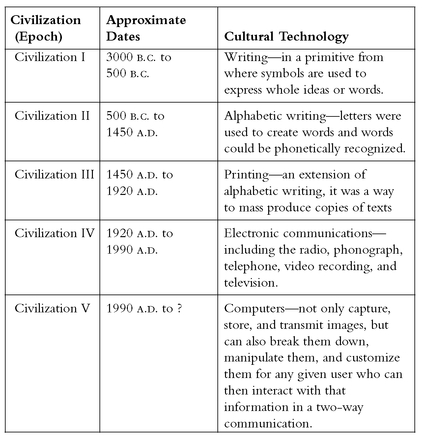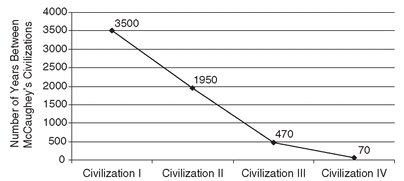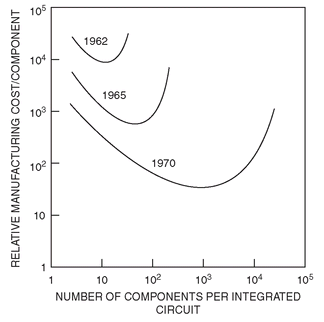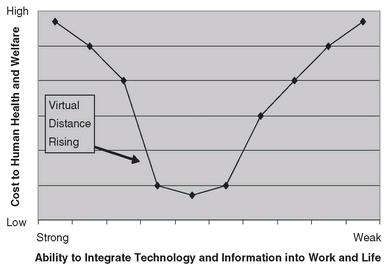10
The Future
Throughout this book, we’ve defined Virtual Distance and discussed how it is created. We’ve also talked about its impact on several important outcomes, including performance, leadership, and innovation. Now we take a look ahead and share some of our thoughts on the potential ways in which the Virtual Distance Model could help us into the future.
To recap, Virtual Distance is a by-product of our technological age, embodying a perceived sense of separateness that’s risen as communications have become increasingly technologically based and as dramatic changes in the way we work continue to develop.
Virtual Distance as a phenomenon has emerged in the past decade or so. As it continues to increase, there’s also been a human cost accompanying the increasing role that technology plays in our social and workplace interactions. In a recent interview, Michael Dell talked about having to turn off his Blackberry during nonworking hours because his family life was suffering as a result of his always being available, connected, and able to work from a distance. This is another side of virtual work—it’s accessible 24 hours a day, seven days a week. So the distinction between work and personal life becomes blurred.
Virtual Distance is rising at a time when technology as well as business models are changing. Some, like those discussed in Chapter 6, have been so rapid and extreme, we’ve had difficulty adapting fully. As human beings, we can integrate only so much of our work activity into our everyday life before becoming overloaded. When this happens, as we discussed in Chapter 2, a cognitive and emotional distance builds. This kind of Virtual Distance occurs for three reasons:
1. Our values, relationships, social status, and/or level of interdependence are not in harmony (affinity distance).
2. Our ability to handle daily operational challenges like multitasking, and selecting the right communication method for the right kind of message that includes all the right meaning is a strain. Add continual challenges posed by technology, and we can become overtaxed and lose our natural sense of who we are through isolation or a collective blindness that comes from being too shielded from others (operational distance).
3. Our physical locations, time zones, and group affiliations are scattered and remote (physical distance).
As we discussed in Chapter 3, high Virtual Distance can result in diminished capacity to innovate, cooperate, and develop close bonds with others. But with our new understanding of Virtual Distance, we now have the insight and tools needed to collectively work through some of these difficulties. To do so, though, requires an understanding of the extraordinary changes that have taken place in such a compressed time frame. To put these into perspective, we first take a brief look at how, historically, prior communication technology affected society.
CULTURAL TECHNOLOGIES THAT CHANGED THE WORLD
In his book Five Epochs of Civilization, William McGaughey categorizes world history, as we know it so far, in terms of five civilizations punctuated by what he calls “cultural technology.”1 He defines cultural technology as a way to “amplify personal experience” and includes five communication technologies that profoundly changed the way in which we live. Each civilization is approximated, and a summary of McGaughey’s historical interpretation is shown in Figure 10.1.
FIGURE 10.1 Summary of the “Five Epochs of Civilization”

As you can see from Figure 10.1, McGaughey was careful not to say when the fifth civilization might end—the Computer Epoch (McGaughey uses civilization and epoch to mean the same thing). However, we became curious to see if there was a relationship between cultural technologies and the time changes between them. So we plotted a chart to test our notion that there may be some clues to take away from McGaughey’s work with respect to our future. Our results are shown in Figure 10.2.
This chart shows an interesting pattern, one that echoes other technological advancements mapped against time. In a paper written by Gordon Moore, Intel’s cofounder, and published in Electronics magazine in April 1965, he posited that the number of transistors that could be put onto a square inch of silicon would double about every 24 months.2
FIGURE 10.2 Chart of McCaughey’s Civilizations Over Time

It would appear that a similar kind of logarithmic curve is shown with respect to cultural technologies through the ages. For example, 1,950 years, the approximate length of Civilization II, is about one-half that of the 3,500 years of Civilization I. Four hundred seventy years, the length of Civilization III is approximately half the prior difference, and 70 years, the elapsed time of Civilization IV, is approximately half the previous difference as well. If we take this formula to predict how long Civilization V might last, we’d estimate it to be 5 years.
That would take us to 1995, the year in which Netscape, the first commercially available Internet browser, hit a critical mass of almost 100 million people. In fact, many scientists, including economists, use 1995 as a critical cutoff year representing a pre- versus post-Internet economy. Could the World Wide Web and commercial Internet have ushered in Civilization VI? The Internet Epoch, like Civilization III, is punctuated by a new technology that allows us to duplicate as well as manipulate unlimited copies of anything that’s been printed, videotaped, or recorded in any way.
Perhaps this is the case. However, if we try and move ahead with this calculation, we soon run out of measurable time. The next Civilization would last less than one year, the next less than one minute, and then nano-seconds and so forth, until time differences, at least the way we understand them as humans, would be imperceptible. The speed of change is, then, increasing so quickly that our ability to adapt and control it is becoming problematic. And if Virtual Distance is high now, what can we expect as technology races forward?
In another parallel, McGaughey’s time line, characterized by ever-decreasing rates of decline, also looks similar to a portion of yet another one of Gordon Moore’s charts called the “costs and curves” graph. Jon Stokes, in his 2003 paper, “Understanding Moore’s Law,” reexamined Moore’s original work.3 He highlights the fact that while Moore’s prediction of circuits doubling on the same size chip regularly was certainly what he was most famous for, another valuable insight came from his revelation that the costs of developing a highly dense chip would eventually give way to rising defects and other problems that would make integration too expensive. This would require abandoning the original technology at some point in favor of building a better one. Moore’s original “costs and curves” graph is presented in Figure 10.3.
FIGURE 10.3 Costs versus Integration
Source: 2003. Jon Stokes. Understanding Moore’s Law, http://arstechnica.com/articles/paedia/cpu/moore.ars/3.

According to this chart, while the number of integrated components rises as costs fall in the first part of the curve, eventually, the cost to produce each component begins to rise in the latter half of the curve. Stokes asserts that this is because the number of good chips or “yield” suffers when integration becomes too compressed. Put another way, the complexity is too much for the chip to handle without a lot of costly errors.
A similar curve might be helpful in understanding the potential value of Virtual Distance.
Consider for a moment that there’s an analogous curve tracing the costs to maintain or improve human health and welfare, set against our ability to integrate technology and information into our work and lives. If we were to draw such a curve, it may be that the rise of Virtual Distance is signaling to us that we’re approaching a point of diminishing returns. Figure 10.4 shows an example of such a relationship.
FIGURE 10.4 Virtual Distance Rising

As better technology was introduced, the cost of health and welfare fell in many areas. New drugs were discovered that would have been almost impossible to find without the help of highly sophisticated algorithms and uniquely computer-based computations. Our understanding of the human genome and other major scientific breakthroughs were, in fact, possible only because of vast computing power. Results such as the mortality rates of newborns have steadily declined in developed countries and are finding their way into developing countries as well. Average life spans have increased all over the world. In other areas, we are now able to model or simulate certain kinds of problems like the effects of global warming. At Arizona State University, the “Decision Theater” combines visualization, simulation, and cognitive science to examine major policy questions. The work of the Decision Theater has been credited with helping to avoid major environmental disasters by changing plans for major developments.
We’ve also taken much of the cost out of doing business. True, we still have real estate, offices to keep up, electric bills to pay, and so on; however, relative costs have come down and continue to decline as our ability to use computing power with better, cheaper, and faster communication lines increases. We’ve also acquired cheaper labor through global arbitrage and taken advantage of a vast pool of international skills and expertise. We are able to more easily and quickly integrate needed information into our work and research, which has led to higher productivity. We can, on a moment’s notice, do market research on a new product or find out how the earliest Greek scriptures compare against modern-day orations and quickly discern similarities and differences between us and the ancients.
So, although technology increasingly serves us in many fruitful ways, Virtual Distance is rising due to decreasing levels of physical closeness; problems with day-to-day activities, which often includes an overabundance of technological communications; and decreasing emotional ties developed through affinity building. Just as Elton Mayo discovered that a “human touch” could help productivity rise almost a century ago, Virtual Distance is telling us that a bit of the same might help us even in this highly technological era. In fact, it’s likely that lowering Virtual Distance could be the way in which companies avoid higher costs overall into the future.
The Virtual Distance Model clearly shows that getting to highly satisfying work that meets the need for selfactualization and socialization is possible even if we’re far apart, working with a lot of technology. To lower Virtual Distance in the future, we need to build Virtual Distance management plans to ensure better integration between our behaviors and our technologies. In the future, to avoid climbing too far up on the latter portion of Moore’s cost curve, we need to focus on five critical activities, which we’ve described for you in this book:
1. Meet, measure, map, and manage Virtual Distance up front.
2. Produce ambassadorial leaders.
3. Reimagine the virtual workforce as virtual ensembles.
4. Look for opportunities to leverage Virtual Distance, as well as minimize it in innovation activities.
5. Select communication technologies based on Virtual Distance profiles.
If we implement this five-step plan, our future will consist of a virtual workforce that’s united through lowered Virtual Distance, higher levels of trust and empathy, an increased willingness to help one another, and elevated clarity around vision and goals that are linked where need be, but that also serve individual needs across the network.
And it’s not just current management and communication technology that will drive the need to manage Virtual Distance more closely in the future. As we speak, major companies are planning ways to develop 3-D virtual worlds where “universal avatars,” virtual facsimiles of ourselves, will be able to roam in and out of any virtual world. The purpose will be to advance work technologies to even further mimic the ways we’ve worked together in the past. So in cases where Virtual Distance is high between us as “real” people, what might happen when we find ourselves working together as virtual people? It may mean that we’ll have no way to know for sure if our colleagues are real or simply computer generated, for example. But if Virtual Distance is not dealt with, then in the very worst of cases, we may begin to lose empathy for one another—empathy derived from trust and a shared sense of purpose. And if this happens, then our working lives would become less satisfying and increasingly sterile.
While that outcome seems extreme, we may in fact be entering into an extraordinary evolutionary shift. Baroness Susan Greenfield, neuroscientist and director of the Royal Academy in London, in her book Tomorrow’s People,4 illuminates a possible future full of human beings experiencing life almost completely through a computer-augmented reality. Others, like Edward Tenner, demonstrate how technology creates ever-increasing states of complexity to which we must constantly react and adapt. In his book Why Things Bite Back,5 he describes how seemingly benign advancements can create the need for us to evolve in order to keep up with our own creations.
But in almost all of these futuristic points of view—whether they are scientifically based or even created as fictional works—there’s almost always a scenario that features a strong hope that we will “rediscover” our humanity in a way that’s positive and moves us ahead as a whole society. In many respects, that’s what Mayo discovered almost a century ago when the notion of the mechanistic man was peaking. We believe Virtual Distance can do that for us now.
Virtual Distance gives us a road map that allows us to better understand how we can drift apart and “forget” that we are in fact creatures of emotion and good intent. The Virtual Distance Model helps us to see how we become untethered and provides us a way back to ourselves and each other. By mapping Virtual Distance, we are able to specifically ignite our vision and correct for things that have gone awry. Our ability to assign specific costs to Virtual Distance helps us to measure its direct impact on the bottom line.
Once Virtual Distance effects are quantified, we can rebalance the variables in the distance equation so that they don’t become harmful and instead work in our favor. But this will not be easy because it means “abandoning” our prior “fab” (fabrication), as Moore would say, for a newer and better one in terms of management philosophies and technologies. Moore, and later Stokes, argued that once the cost/integration curve inverted, it was time to build something new. And in many respects, people in economics and other global pursuits are reaching that same conclusion with respect to business and economics.
In 2005, economist Stephen Roach wrote that it’s time to “give up our time-honored relationships” due to the changed landscape of global information and communication technologies and the effects they’re having on world economic models. Neuroscientists like Martin Westwell and Susan Greenfield are focusing their attention on how technologies impact the human brain. Adele Diamond, another researcher, has shown that we need to focus on helping our children at ever-younger ages learn how to develop human relationships without technological mediation. In her award-winning research, she showed that children who were taught to learn how to pay attention to each other in kindergarten and even earlier, went on to lead much more productive and happier lives.
Given this mounting evidence, Virtual Distance—the recognition of it as well as the need to manage it—is becoming more urgent. There is only a short window, perhaps a few years, in which to adjust our course before the next iteration of collaboration technology is implemented on a global scale. We believe that with the discovery of Virtual Distance and the tools we’ve presented here, we can recognize it, map it, and manage it. New tools can also be developed to help steer our collective ship into a safer harbor and, there, find the next “fab” that will catapult us into a world that’s better than the one we live in today.
NOTES
1 William McGaughey, Five Epochs of Civilization: World History as Emerging in Five Civilizations (Minneapolis, MN: Thistlerose Publications, 2000).
2 Gordon Moore, Cramming more components on to integrated components, Electronics April, 1965.
3 Jon Stokes, Understanding Moore’s Law. http://arstechnica.com/articles/paedia/cpu/moore.ars.
4 Susan Greenfield, Tomorrow’s People (London: Allen Lane, 2003).
5 Edward Tenner, Why Things Bite Back: Technology and the Revenge of Unintended Consequences, (New York: Knopf, 1996).
..................Content has been hidden....................
You can't read the all page of ebook, please click here login for view all page.
